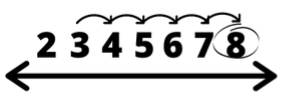General Information
Benchmark Instructional Guide
Connecting Benchmarks/Horizontal Alignment
Terms from the K-12 Glossary
- Equation
- Expression
- Number Line
Vertical Alignment
Previous Benchmarks
Next Benchmarks
Purpose and Instructional Strategies
The purpose of this benchmark is to build upon the exploration of MA.K.NSO.3.1 and provide students with opportunities to become more efficient in their selection and use of strategies. The goal is not to be fluent with addition and subtraction, but rather to build the foundation for fluency in later grades (MTR.3.1).- Instruction includes the use of manipulatives and pictorial representations.
- Instruction allows students to continue exploring various strategies for addition and subtraction, discovering strategies that allow them to become more efficient (MTR.2.1).
- Instruction includes the use of discussions where students share strategies with one another (MTR.4.1).
- Though the first expectation for procedural fluency with addition and subtraction is not
until Grade 2, instruction allows students to become more efficient through choosing appropriate strategies (MTR.3.1).
- For example, students moving from combining then counting sets to counting on.
- Instruction includes the use of the commutative property (not by name) as a strategy for
adding. This is connected to the Cardinality Principle – the total number remains the same after rearrangement (MTR.5.1).
- For example, allow students to discover that 7 + 2 = 9 and 2 + 7 = 9 to help develop the understanding of the commutative property.
- Instruction includes the use of context to provide a purpose for adding or subtracting, and to develop conceptual understanding for addition and subtraction (MTR.7.1).
- The goal of this benchmark is not to get to automaticity; however, students should begin to experience strategies that move them toward more efficiency.
- Allowing students to discover the commutative property will allow them to continue exploring and developing understanding, while becoming more efficient with their strategies (MTR.3.1).
- For example, to find 2 + 7 by counting on, it is more efficient to begin with 7 and count on 2.
Common Misconceptions or Errors
- Students may not see the value in counting on (and becoming more efficient) when determining the number of objects in two sets that have been combined.
- When using the count on strategy, students may always start with the first number rather than the larger number.
Strategies to Support Tiered Instruction
- Instruction includes using numbered cards 4 − 10 and dot cards with 1, 2, or 3 dots, which can be combined to model an equation. Students say the number, touch each dot as they count forward (or backward), and record the equation which can be solved by using either counting on or counting back strategy, depending on the students need. Students can move toward identifying both addition and subtraction equations.

- Instruction includes using the same activity above. Replace the dot cards with cards numbered 1, 2, or 3. If the student chooses to start counting on the 1, 2, or 3 card instead of the card with the larger number, ask the student to model their count using a number line. Have the student draw the jumps on each model and compare which makes the most sense. Note that both ways get the same answer, yet one is more efficient than the other.
- For example, to find 2 + 7 by counting on, it is more efficient to begin with 7 and count on 2.”
- For example, the teacher can use questions and statements that can help elicit student thinking about starting on the bigger number can include:
- “How did you know to start on 7 instead of 2?”
- “Let’s see what happens if we start on the lower number. Then, let’s try starting on the higher number. Which way was more efficient?”

Instructional Tasks
Instructional Task 1
Provide students with white boards and markers and counters, linking cubes, ten frames, number lines and other various tools for adding and subtracting. Present students with an addition or subtraction problem, such as 4 + 3. Encourage students to solve the problem using a strategy of their choice, but do not allow them to answer to the group. The teacher reveals the sum or difference, then have students brainstorm and discuss all the strategies they used to find the answer. The teacher collects all of the strategies and facilitates a conversation around various strategies, and ways to choose reliable methods. This task focuses on sharing strategies.Instructional Task 2
Give students two groups of objects. One group has 3 objects and the other group has 4 objects. Ask for the total combined number of objects. Once students find the combined total, collect the objects and redistribute by giving students the group of 4 objects first, and then the group of 3 objects. See if students recognize that the combined total is the same. This task illustrates the commutative property and also the cardinality principle because changing the order of groups can be seen as rearranging the items of the combined group. Now that the students have the combined group of 7 objects, ask them to remove any of the 3 objects and determine how many are left. Discuss the connection.
Instructional Items
Instructional Item 1

Instructional Item 2
*The strategies, tasks and items included in the B1G-M are examples and should not be considered comprehensive.
